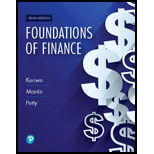
Concept explainers
Case summary:
It’s been 2 months since individual X took a position as a collaborator budgetary examiner at C Items. In spite of the fact that your boss has been satisfied with his work, he is still a bit reluctant almost unleashing individual X without supervision. Individual X's other task includes both the calculation of money streams related to a modern venture beneath thought and the assessment of a few commonly select ventures. Given individual X's need for residency at C, y have been asked not as it were to supply a suggestion but too to reply to a number of questions pointed at judging his understanding of the capital budgeting handle. We are considering the presence of an unused item. As of now, we are within the 21 percent minimal charge bracket with a 15 percent required
To determine: The manner in which simulation works and the value in using a simulation approach.
Want to see the full answer?
Check out a sample textbook solution
Chapter 11 Solutions
Foundations Of Finance
- Delta Corporation has the following capital structure: Cost Weighted (after-tax) Weights Cost Debt 8.1% 35% 2.84% Preferred stock (Kp) 9.6 5 .48 Common equity (Ke) (retained earnings) 10.1 60 6.06 Weighted average cost of capital (Ka) 9.38% a. If the firm has $18 million in retained earnings, at what size capital structure will the firm run out of retained earnings? b. The 8.1 percent cost of…arrow_forwardDillon Enterprises has the following capDillon Enterprises has the following capital structure. Debt ........................ 40% Common equity ....... 60 The after-tax cost of debt is 6 percent, and the cost of common equity (in the form of retained earnings) is 13 percent. What is the firm’s weighted average cost of capital? a. An outside consultant has suggested that because debt is cheaper than equity, the firm should switch to a capital structure that is 50 percent debt and 50 percent equity. Under this new and more debt-oriented arrangement, the after-tax cost of debt is 7 percent, and the cost of common equity (in the form of retained earnings) is 15 percent. Recalculate the firm’s weighted average cost of capital. b. Which plan is optimal in terms of minimizing the weighted average cost of capital?arrow_forwardCompute Ke and Kn under the following circumstances: a. D1= $5, P0=$70, g=8%, F=$7 b. D1=$0.22, P0=$28, g=7%, F=2.50 c. E1 (earnings at the end of period one) = $7, payout ratio equals 40 percent, P0= $30, g=6%, F=$2,20. Note: D1 is the earnings times the payout rate. d. D0 (dividend at the beginning of the first period) = $6, growth rate for dividends and earnings (g)=7%, P0=$60, F=$3. You will need to calculate D1 (the dividend after the first period).arrow_forward
- Terrier Company is in a 45 percent tax bracket and has a bond outstanding that yields 11 percent to maturity. a. What is Terrier's after-tax cost of debt? b. Assume that the yield on the bond goes down by 1 percentage point, and due to tax reform, the corporate tax falls to 30 percent. What is Terrier's new aftertax cost of debt? c. Has the after-tax cost of debt gone up or down from part a to part b? Explain why.arrow_forwardThe Squeaks Cat Rescue, which is tax-exempt, issued debt last year at 9 percent to help finance a new animal shelter in Rocklin. a. If the rescue borrowed money this year, what would the after-tax cost of debt be, based on its cost last year and the 25 percent increase? b. If the receipts of the rescue were found to be taxable by the IRS (at a rate of 25 percent because of involvement in political activities), what would the after-tax cost of debt be?arrow_forwardNo chatgptPlease don't answer i will give unhelpful all expert giving wrong answer he is giving answer with using incorrect values.arrow_forward
- Please don't answer i will give unhelpful all expert giving wrong answer he is giving answer with incorrect data.arrow_forward4. On August 20, Mr. and Mrs. Cleaver decided to buy a property from Mr. and Mrs. Ward for $105,000. On August 30, Mr. and Mrs. Cleaver obtained a loan commitment from OKAY National Bank for an $84,000 conventional loan at 5 percent for 30 years. The lender informs Mr. and Mrs. Cleaver that a $2,100 loan origination fee will be required to obtain the loan. The loan closing is to take place September 22. In addition, escrow accounts will be required for all prorated property taxes and hazard insurance; however, no mortgage insurance is necessary. The buyer will also pay a full year's premium for hazard insurance to Rock of Gibraltar Insurance Company. A breakdown of expected settlement costs, provided by OKAY National Bank when Mr. and Mrs. Cleaver inspect the uniform settlement statement as required under RESPA on September 21, is as follows: I. Transactions between buyer-borrower and third parties: a. Recording fees--mortgage b. Real estate transfer tax c. Recording fees/document…arrow_forwardHello tutor give correct answerarrow_forward
 Intermediate Financial Management (MindTap Course...FinanceISBN:9781337395083Author:Eugene F. Brigham, Phillip R. DavesPublisher:Cengage Learning
Intermediate Financial Management (MindTap Course...FinanceISBN:9781337395083Author:Eugene F. Brigham, Phillip R. DavesPublisher:Cengage Learning Accounting Information SystemsAccountingISBN:9781337619202Author:Hall, James A.Publisher:Cengage Learning,Principles of Accounting Volume 2AccountingISBN:9781947172609Author:OpenStaxPublisher:OpenStax College
Accounting Information SystemsAccountingISBN:9781337619202Author:Hall, James A.Publisher:Cengage Learning,Principles of Accounting Volume 2AccountingISBN:9781947172609Author:OpenStaxPublisher:OpenStax College Intermediate Accounting: Reporting And AnalysisAccountingISBN:9781337788281Author:James M. Wahlen, Jefferson P. Jones, Donald PagachPublisher:Cengage Learning
Intermediate Accounting: Reporting And AnalysisAccountingISBN:9781337788281Author:James M. Wahlen, Jefferson P. Jones, Donald PagachPublisher:Cengage Learning Cornerstones of Cost Management (Cornerstones Ser...AccountingISBN:9781305970663Author:Don R. Hansen, Maryanne M. MowenPublisher:Cengage Learning
Cornerstones of Cost Management (Cornerstones Ser...AccountingISBN:9781305970663Author:Don R. Hansen, Maryanne M. MowenPublisher:Cengage Learning Managerial Accounting: The Cornerstone of Busines...AccountingISBN:9781337115773Author:Maryanne M. Mowen, Don R. Hansen, Dan L. HeitgerPublisher:Cengage Learning
Managerial Accounting: The Cornerstone of Busines...AccountingISBN:9781337115773Author:Maryanne M. Mowen, Don R. Hansen, Dan L. HeitgerPublisher:Cengage Learning





